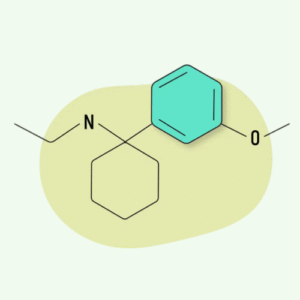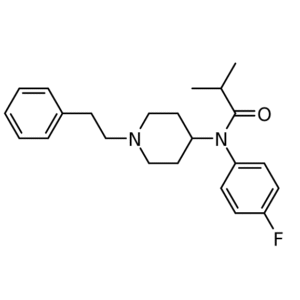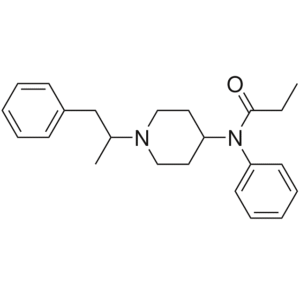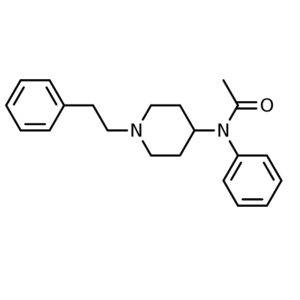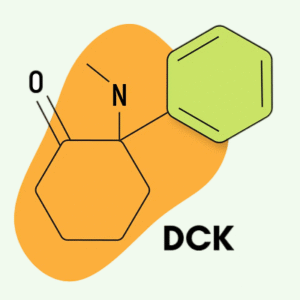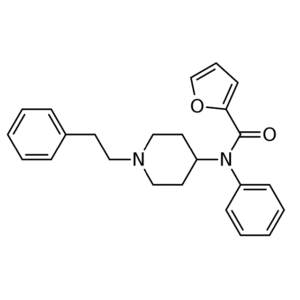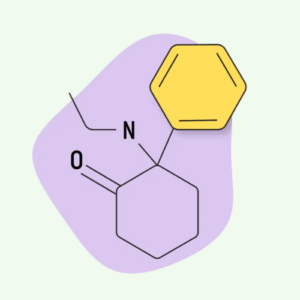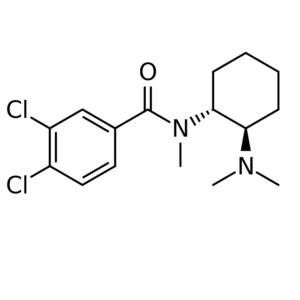Dissociative/Analgesics
Arylcyclohexylamines/Analgesic
Dissociative hallucinogens form a unique category of psychoactive substances known for their ability to alter perception, mood, and consciousness by disrupting communication between the brain and body. Unlike classic psychedelics, which intensify sensory experiences, dissociative hallucinogens often create a sense of detachment from one’s environment or even from oneself. This effect, often referred to as dissociation, has made these compounds a subject of great interest in both scientific research and therapeutic exploration.
One of the most studied properties of these substances is dissociative analgesia—the phenomenon where pain perception is significantly reduced while the user remains partially conscious. This makes certain dissociatives valuable in clinical and veterinary medicine, where traditional anesthesia may not be ideal. Compounds such as ketamine have been investigated for both their analgesic effects and their emerging role in mental health treatments, particularly for conditions like depression and post-traumatic stress disorder (PTSD).
As interest in this category continues to grow, dissociative hallucinogens are being examined for their unique pharmacological profiles and potential applications. While their effects can vary widely depending on the specific substance, dosage, and individual response, they remain a key area of research in neuroscience, psychopharmacology, and medical practice.
Arylcyclohexylamines drugs uses encompass a range of pharmacological applications, primarily studied for their dissociative and anesthetic properties. These compounds interact with the central nervous system by modulating NMDA receptors, leading to alterations in perception, pain response, and consciousness. Researchers explore these drugs to understand their potential in pain management, anesthesia, and experimental neuroscience. Beyond therapeutic applications, arylcyclohexylamines provide models for studying neurochemical pathways, cognitive effects, and receptor interactions. The versatility of these compounds makes them valuable in both laboratory and clinical research settings, providing insight into how chemical structure affects pharmacodynamics and pharmacokinetics.
Arylcyclohexylamines Drugs Uses
Laboratories investigating arylcyclohexylamines drugs uses often focus on controlled studies to examine analgesic, anesthetic, and neuroprotective properties. Preclinical models allow scientists to evaluate cognitive and behavioral outcomes, while also analyzing receptor binding, metabolism, and systemic distribution. These studies contribute to the understanding of dissociative pharmacology and help identify compounds with optimized efficacy and minimal adverse effects. In addition, arylcyclohexylamines drugs are used to model neurological disorders, providing insight into potential treatment avenues for conditions such as chronic pain, depression, and neurodegenerative diseases.
Arylcyclohexylamines Drugs Side Effects
While arylcyclohexylamines drugs offer significant research value, understanding their arylcyclohexylamines drugs side effects is critical. Common adverse effects observed in studies include dizziness, dissociation, hallucinations, elevated heart rate, and impaired coordination. Research emphasizes careful dosing, monitoring, and controlled experimental conditions to mitigate risks. By studying side effect profiles, scientists gain insights into mechanisms underlying toxicity, tolerance, and potential abuse, which informs the design of safer derivatives. These safety studies are essential in balancing experimental benefits with ethical responsibilities in laboratory research.
Analysis of Arylcyclohexylamines Drugs
Comparing various arylcyclohexylamines compounds allows researchers to evaluate potency, efficacy, and side effect profiles. Such comparative studies highlight structural differences and their influence on NMDA receptor binding and systemic metabolism. By examining these variations, scientists can prioritize compounds with favorable pharmacokinetics, therapeutic potential, and manageable side effects. This comparative framework supports innovation in experimental anesthetics, neuropharmacology research, and the development of new investigative tools for neurological studies.
Analgesic and Antipyretic Drugs
The category of analgesic drugs encompasses a wide range of compounds that are designed to reduce or block pain perception. These drugs work through different mechanisms within the central and peripheral nervous systems, helping researchers understand how the body processes pain signals. Analgesic drugs are divided into several classes, including non-opioid analgesics, opioids, and adjuvant agents. Each class demonstrates distinct pharmacological properties and offers valuable models for studying the physiology of pain and the modulation of nociceptive pathways. In laboratory and clinical research, analgesic drugs provide crucial insights into how chemical structures influence biological responses, guiding the development of new and more effective compounds.
Research Applications of Analgesic Drugs
The research surrounding analgesic drugs often involves studies of pain thresholds, receptor interactions, and dose-response relationships. Scientists use these compounds to explore the balance between efficacy and safety, particularly focusing on side effect profiles and long-term use. Analgesic drugs also serve as comparative models for evaluating newly synthesized molecules. By examining the molecular action of analgesics, researchers can better understand the mechanisms of chronic pain, inflammation, and neural adaptation, making them essential tools in both pharmacology and neuroscience.
Categories of Analgesic Compounds
Among the most prominent analgesic compounds are nonsteroidal anti-inflammatory drugs (NSAIDs), which act by inhibiting cyclooxygenase enzymes to reduce inflammation and pain. Opioid compounds, on the other hand, bind to opioid receptors in the brain and spinal cord, producing strong analgesic effects while also presenting challenges such as tolerance and dependence. Adjuvant analgesic compounds, such as certain antidepressants and anticonvulsants, provide another layer of study, as they modulate pain indirectly by affecting neurotransmitter pathways. The diversity of analgesic compounds makes them valuable for comparative research across different scientific disciplines, enabling deeper insight into the physiology of pain.
Analgesic and Antipyretic Dual Action
The category of analgesic and antipyretic compounds represents a unique subset of chemicals that not only reduce pain but also lower fever. Antipyretic action generally involves the inhibition of prostaglandin synthesis in the hypothalamus, which regulates body temperature. This dual action makes analgesic and antipyretic compounds particularly significant in research, as they demonstrate how a single molecule can exert multiple therapeutic effects. Common examples include widely studied agents like acetaminophen and certain NSAIDs, which provide models for exploring the interaction between pain and fever pathways. Studying these compounds helps researchers understand cross-mechanisms in pharmacology and the potential for multi-target drug design.
Research Significance of Analgesic and Antipyretics
The dual functionality of analgesic and antipyretic compounds provides a versatile platform for scientific studies. Researchers examine how these agents influence both pain transmission and thermoregulation, giving insights into broader physiological processes. Experimental models allow for exploration of molecular signaling pathways, side effect management, and comparative efficacy. These compounds are also key in toxicology studies, as their widespread use in medicine necessitates careful evaluation of dosing, metabolism, and long-term safety. By analyzing analgesic and antipyretic compounds, scientists gain a more holistic view of therapeutic potential and limitations, enriching the field of pharmacology.
Accessing Dissociative Research Compounds
From the study of analgesic drugs to the exploration of diverse analgesic compounds, and the dual-action category of analgesic and antipyretic, these substances remain essential to advancing pharmacological and biomedical knowledge. Laboratories and research institutions rely on high-quality materials to ensure reliable results and groundbreaking discoveries.
Showing all 10 results
-
Dissociative/Analgesics
A-Methylfentanyl
Price range: 488.00$ through 1,730.00$Clear56 g224 g (incl. free delivery) -
Dissociative/Analgesics
Acetyl Fentanyl
Price range: 488.00$ through 1,730.00$Clear56 g224 g (incl. free delivery) -
Dissociative/Analgesics
Esketamine
Price range: 387.00$ through 1,535.00$Clear4 x 28 mg-device20 x 28 mg-device -
Dissociative/Analgesics
Furanylfentanyl
Price range: 488.00$ through 1,730.00$Clear56 g224 g (incl. free delivery)
